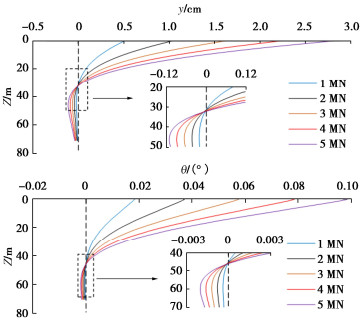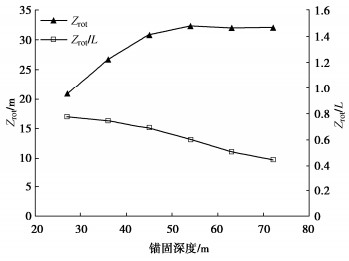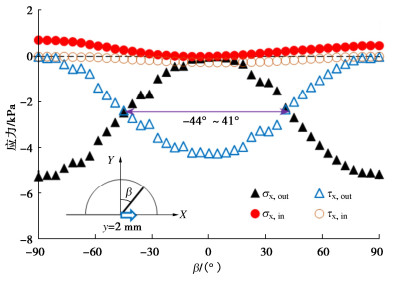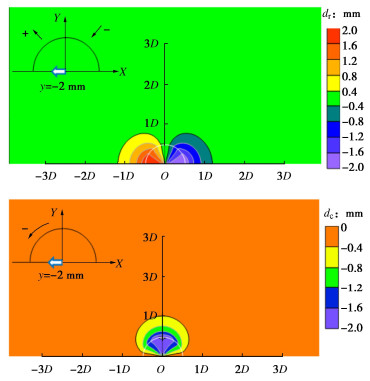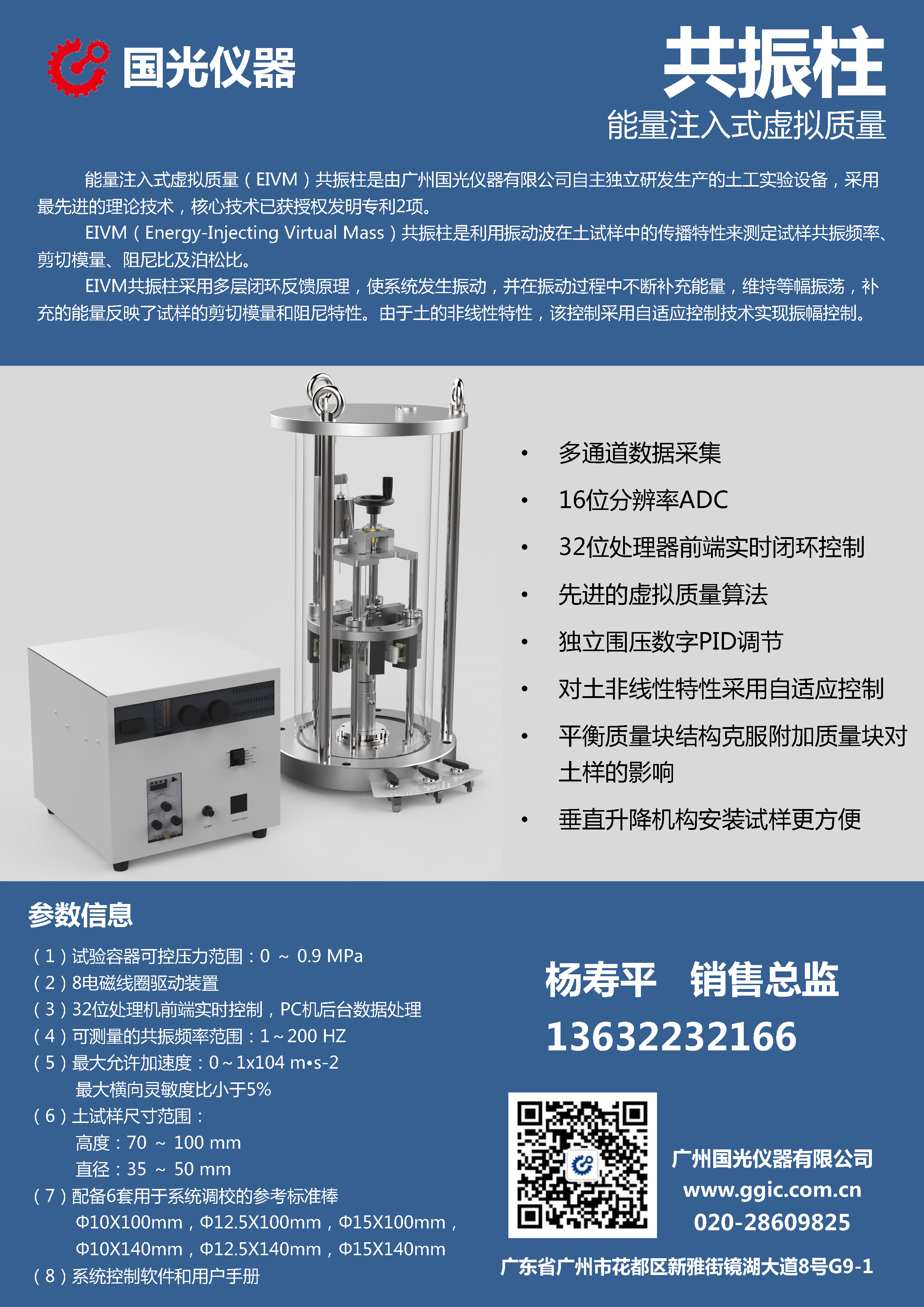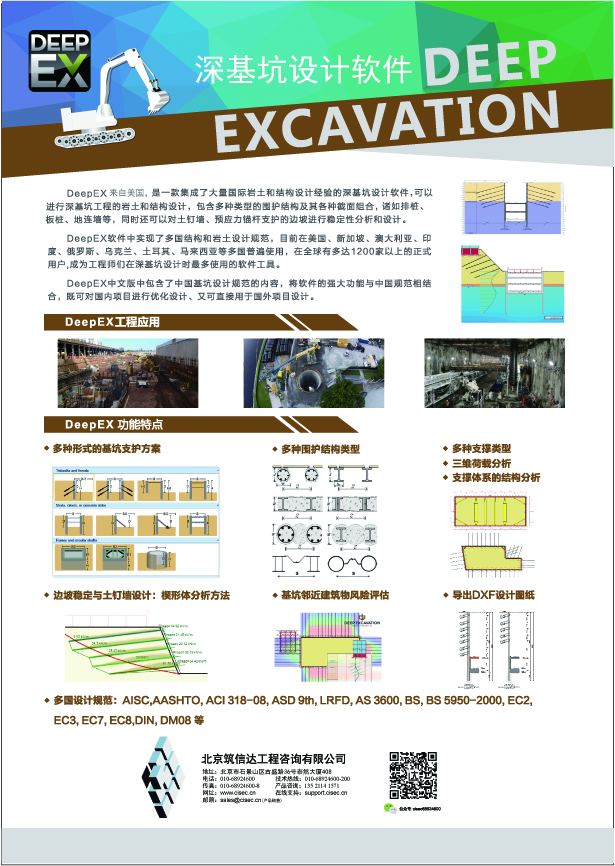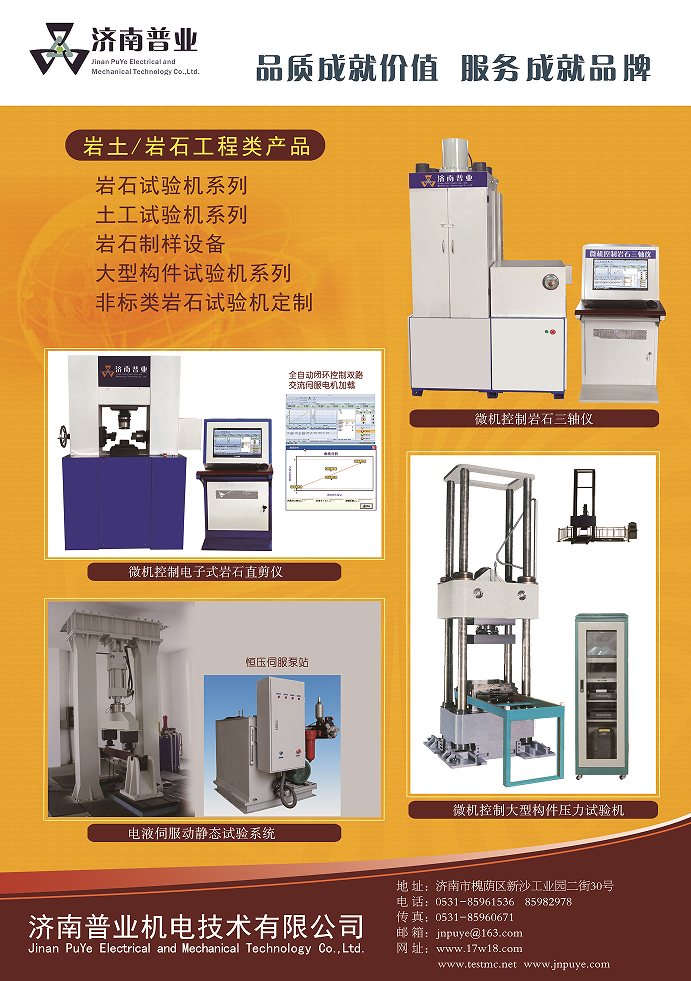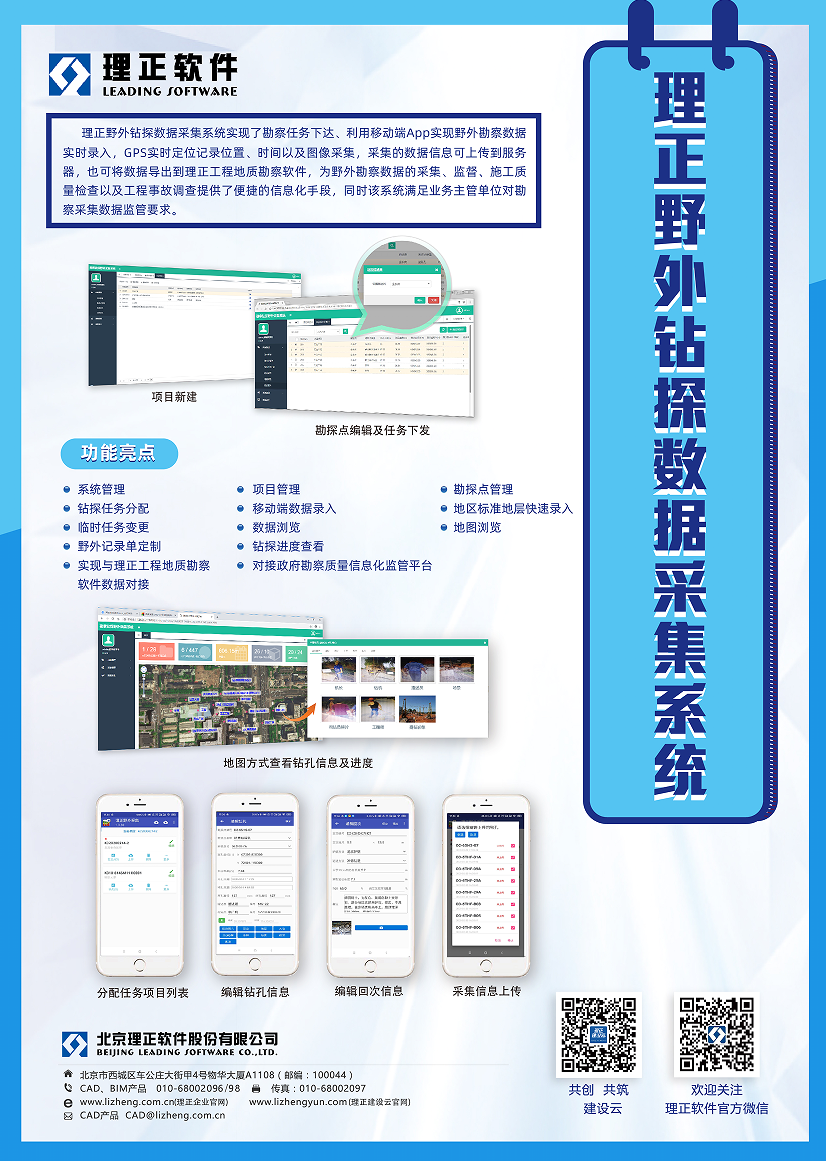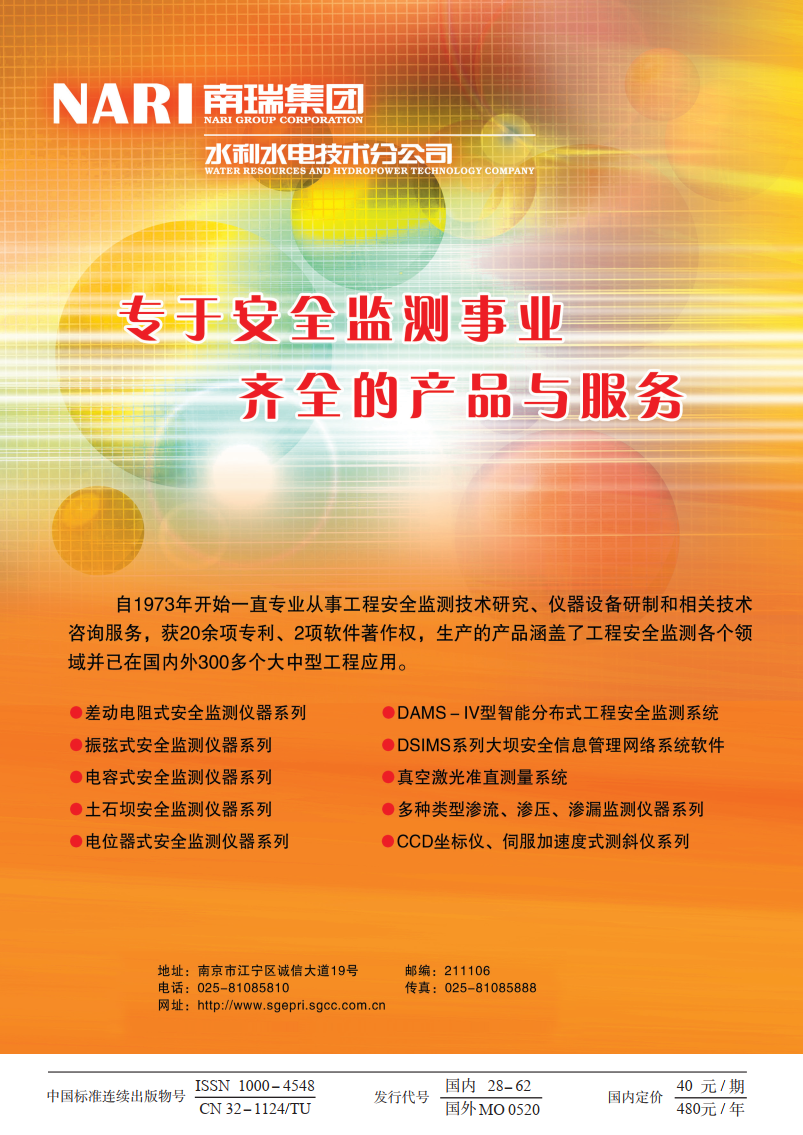Small-displacement behavior of offshore wind power monopiles subjected to static lateral loading
-
摘要: 针对海上风电桩径9 m的超大直径单桩基础,采用离心模型试验与数值仿真相结合方法,研究砂土地基中不同锚固深度工况下单桩基础在小变位条件下的水平静力承载特性。结果表明,随锚固深度增加,桩身旋转中心逐渐下移,且桩身水平位移与倾角沿桩身分布的非线性趋势逐渐增强。不同锚固深度工况下桩侧p-y曲线间的差异随深度逐渐加大,在趋势上,p-y曲线随锚固深度增大由外凸型向内凹型转变;在量值上,同一深度处初始割线模量间可相差4倍。这一差异的原因在于,同一深度处桩体发生相同侧位移时,锚固更浅的桩体周围土体内部径向位移、环向位移的影响范围较小,土体应变较大,进而呈现较大的水平抗力。研究成果有助于深化对大直径单桩基础承载机制的认识,进而为桩体设计优化提供理论基础。Abstract: The centrifuge tests and numerical simulations are carried out to explore the small-displacement behavior of 9 m-diameter offshore wind power large-scale monopiles with various embedment depths. The results show that as the embedment depth increases, the rotation center gradually moves downward, and the nonlinear characteristics of lateral displacement and rotation angle distributions along piles are gradually enhanced. The difference among p-y curves of monopiles with various embedment depths gradually increases with depth. In terms of trend, the p-y curve changes from convex to concave with the increasing embedment depth. In terms of magnitude, the initial secant modulus at the same depth can differ by 4 times. It can be explained as follows: when the same lateral displacement occurs at the same depth, the monopiles with relatively smaller embedment depths show smaller influence zones of both radial and circumferential displacements in the surrounding soils, and then the soil strain is larger, which eventually contributes to a larger horizontal resistance on piles. The research results help to deepen the understanding of the load-transfer mechanisms of large-diameter monopiles, and to provide a theoretical basis for the optimization of associated design approaches.
-
Keywords:
- centrifuge test /
- finite difference method /
- monopile /
- p-y curve /
- embedment depth
-
0. 引言
单桩基础具有制作简单、施工快捷、综合成本低等优点,是当前海上风电场应用最广泛的基础型式,占全球已建海上风电场机组基础安装量的70%以上[1]。近年来,海上风电机组呈现大型化发展趋势,单机容量跃升式增加,对基础结构承载性能提出更高要求[2-3]。中国广东阳江海域海上风电场单桩基础的最大直径达到9 m,揭阳海域海上风电场单桩基础的最大直径达到10.5 m,是当前沉桩完成的最大直径单桩。然而,目前针对此等规格的超大直径单桩基础的研究较少,现场试桩试验的桩径一般不大于2.5 m[3-6],而离心模型试验模拟的原型桩径一般不大于6.5 m[7-10],因此,开展桩径9 m的超大直径单桩基础水平承载特性研究是十分必要的。
海上风电机组安全稳定运行对基础结构倾斜度的要求极为严格,水平承载特性分析的关键并不在于基础结构的极限承载能力,而在于机组正常运行状态,其控制性指标往往是运行期内数百万次以上的水平循环荷载引发的桩体累积变位[11]。挪威船级社规范[12]中规定泥面处倾角限值为0.5°,考虑施工误差值0.25°,整个运行期基础结构循环累积变形容许量仅为0.25°。中国规范NB/T 10105[13]沿用了此限值。开展静力条件下桩体受力变形分析,是正常使用极限状态分析的基础。在海上风电机组基础工程设计中,p-y曲线法是开展桩基础设计分析的基本方法[12-14],然而,对于超大直径单桩基础,已有研究[7, 15-17]表明API规范[14]推荐的p-y曲线法存在高估初始地基刚度、低估极限状态水平抗力的问题,若以p-y曲线的割线模量(Δp/Δy)描述初始地基刚度,小变位条件下刚度计算值偏大,然而在大变形条件下刚度计算值偏小。研究学者[24]指出这一缺陷会造成海上风电单桩基础设计过于保守。然而,如前所述,桩体设计主要取决于小变位水平承载特性。若API规范推荐的p-y曲线对小变位割线模量(Δp/Δy)存在较大程度的高估,正常运行工况下的单桩基础设计极有可能偏激进,从而影响结构服役性能。Abdel-Rahman等[18]研究表明,采用API推荐的p-y曲线法低估了水平荷载作用下泥面处倾角,低估程度可达20%。因此,亟待揭示超大直径单桩基础小变位水平静力承载特性,探讨p-y曲线法对于超大直径单桩基础的适用范围。
本文针对桩径9 m超大直径单桩基础,通过开展离心模型试验和数值仿真,重点研究砂土地基中不同锚固深度工况下单桩基础的桩身变形模式、不同桩身深度处的p-y曲线及其初始割线模量分布,讨论p-y曲线法的适用性,揭示桩周应力分布及土体位移场随锚固深度的变化规律。研究成果有助于深化对超大直径单桩基础承载机制的认识,为单桩基础设计优化提供理论基础。
1. 离心模型试验
离心模型试验依托中国水科院400g·t大型土工离心机开展。该设备为世界首台转速达1000g的高速土工离心机,可按常规(10g~200g)、高速(200g~1000g)两种模式运行。本试验选用常规模式,采用的离心加速度为100g,即N=100。此种模式下,旋转中心到吊篮底板上表面的距离为4.9 m,最大负载2 kN,吊篮内空间尺寸为1.5 m(垂向)×1.0 m(切向)×1.2 m(径向),加速度稳定度≤0.1g。
试验所用的加载设备为基于液压的双向水平荷载加载装置,包括液压站、伺服阀、控制器、反力架、模型箱等主要组件以及真空饱和系统、桩体贯入装置等辅助设备。模型箱内空间直径为700 mm,高度为680 mm,加载点距模型箱内空间底面的高度为66~101 cm,最大加载力为2 kN,最大离心加速度为100g,可实现单向、双向水平加载,并可实现单调加载及循环加载,循环加载频率为0.1~10 Hz,100g下最大加载周次为10000次。本装置的优势是采用球铰结构及直线轴承,保障加载点位于桩轴线上,且桩顶转动与纵向位移(沿轴线方向)均不受限制,进而使得桩体位移更接近真实情况,具体技术细节可参见文献[19,20]。
1.1 试验设计
本次离心模型试验以广东某海上风电场超大直径单桩基础工程设计为基础,其中原型桩的桩径9 m,壁厚9 cm,桩长98 m,锚固深度47 m,机位点海床地质以粉砂为主。试验模型主要包括饱和粉砂地基、单桩基础两部分,如图 1所示。粉砂地基厚度为490 mm,在100g条件下可模拟厚度为49 m的原型地基。模型粉砂采用西峰砂土及某场地粉土混合制备,其级配曲线如图 2所示,物理力学参数参见表 1,其中强度指标为三轴固结排水试验结果。模型桩采用铝合金制备,外径为90 mm,壁厚为3 mm,弹性模量为69 GPa,桩体抗弯刚度EI为53.6 kPa·m4,为原型桩抗弯刚度的1/N4;锚固深度为470 mm,为原型值(L=47 m)的1/N。由此,可满足桩土相对刚度的相似性。在模型底部铺设粒径2~4 mm的细砾层,形成厚度为1 cm的透水层,便于粉砂地基模型的饱和。本试验采用单调单向加载,加载点距泥面510 mm(原型51 m),距桩端980 mm(原型98 m)。需说明的是,考虑实际工程中,中风化或弱风化岩层对单桩基础桩端的影响,离心模型试验中桩端距离箱底较为接近,该设计可能存在一定的边界效应,如可能会高估桩端附近截面弯矩值,但对桩体整体变形模式影响较小。
表 1 粉砂物理力学参数Table 1. Properties of silty sand相对质量密度 干密度/
(g·cm-3)相对密度/
%最大干密度/(g·cm-3) 最小干密度/
(g·cm-3)黏聚力/
kPa内摩擦角/
(°)2.69 1.55 62 1.87 1.21 4 33 1.2 试验测量
为监测桩身应变,泥面以上桩体外表面布设两组全桥应变片,其中,A1/A2/B1/B2距加载点380 mm处,用以监测截面弯矩,进而反算加载点的水平加载力;A3/A4/B3/B4距加载点460 mm,该全桥信号作为反馈信号输入至伺服加载系统。另外,在泥面以下,沿桩体外表面共布设7对1/4桥应变片,自上至下编号为A5/B5、A6/B6、A7/B7、A8/B8、A9/B9、A10/B10、A11/B11,原型测点深度为1,8.5,16,23.5,31,38.5,46 m。为监测桩身倾角,布设激光位移传感器S1、S2,测点位于泥面以上14,44 m处(原型尺度),基于位移量测结果可计算泥面以上14~44 m间桩身的总体倾角(θ')。
1.3 模型制备及试验结果
模型制备过程可分为干砂地基模型制备、地基模型饱和、地基模型上机固结、桩体贯入、加载设备安装等过程。在干砂地基模型制备阶段,为避免砂雨法制备引发的粉土颗粒飘散,选用分层填筑法制模。共25层,第1—第24层每层厚度为2 cm,第25层厚度层厚度为2.5 cm,粉砂层总高度为50.5 cm,每层干密度控制在1.51 g/cm3,略低于目标干密度1.55 g/cm3,经模型饱和及上机固结后,模型干密度接近于目标值。在干砂地基模型制备完成后,放置模型箱顶盖并连接真空饱和系统。为降低水流对模型的扰动,注水速度控制在70 mL/min,注水饱和总时长约为20 h。在完成模型饱和后,将模型箱吊装至离心机吊篮内,启动离心机,在100g条件下进行模型固结。完成模型固结后,在地面1g条件下利用桩体贯入装置安装桩体,其后,吊装模型箱及反力架至离心机吊篮上,将连接件与液压作动器相连,制备完成的模型参见图 3。启动离心机,在100g条件下采用力控制模式逐级加载,监测到的水平加载力及侧位移时程曲线如图 4,5所示。
2. 数值模拟
2.1 模型建立
以离心模型试验为基础,采用有限差分软件FLAC3D研究不同锚固深度工况下单桩基础承载特性,共开展7组数值模拟,单桩基础直径为9 m,锚固深度分别为27,36,45,47,54,63,72 m,即锚固深度与桩径之比(L/D)包括3~8等6种工况,锚固深度47 m的工况与离心模型试验保持一致,加载点到泥面的距离e为51 m。需说明的是,实际工程中泥面以上结构所受合力的加载点并非固定,因本研究聚焦锚固深度的影响,对加载条件进行了简化,保持了加载点固定且e/D值设定为5.7。7种计算工况的图例分别为L_27 m,L_36 m,L_45 m,L_47 m,L_54 m,L_63 m,L_72 m,标记后缀表示锚固深度L。地基水平方向尺寸均与离心模型试验原型情况一致,直径为70 m,桩端距地基竖向边界的距离均设置为27 m。由于本次研究聚焦桩体小变位情况,土体剪应变远低于1%,因此土体本构模型选择时,采用弹性模型,泊松比设为0.3,深度Z处的土体弹性模量为
E=mkp(1+2K0)γZ/3。 (1) 式中:γ为浮重度;K0为静止土压力系数;kp为土体刚度随应力的变化率,有E0.01=kpp,E0.01为轴向应变1%对应的应力应变关系曲线割线模量,p为平均应力,由三轴固结排水试验确定;m为放大系数,由试算确定。本研究取用γ = 9.55 kN/m3,K0= 0.4,kp= 100.55,m = 4。
单桩采用线弹性模型,弹性模量取为210 GPa,泊松比为0.2。桩-土界面的法向及切向刚度均设为1×105 kN/m,摩擦角设为20°,黏聚力设为0。采用位移控制的方式施加荷载,即令加载高程处节点以速度1×10-7 m/s向X轴正向运移。
2.2 方法验证
通过对比锚固深度47 m工况下的离心模型试验结果与数值仿真结果,以验证数值模拟方法的有效性。由图 6可知,水平加载力H与桩身倾角θ'近似呈线性增长的变化趋势,数值结果与试验值基本一致。由图 7可以看出,不同加载等级下桩身弯矩随深度的分布规律的计算结果与试验值较为吻合,因此,本文采用的数值模型能够反映桩体小变位条件下单桩整体承载变形机制及桩体不同深度处截面受力情况。
3. 结果分析
3.1 H-θ0关系
不同锚固深度工况加载力H与泥面处倾角θ0的变化如图 8所示。随单桩基础锚固深度增加,其水平承载能力逐渐提高。泥面处倾角0.25°时的加载力H0.25随L/D逐渐增大,L/D=4,5,6工况下的H0.25比L/D=3、L/D=4、L/D=5时分别增长了63%,23%,5%。当L/D≥6时,继续增加锚固深度最大仅能实现2%的增长,小变位下水平承载能力的提升极为有限。
3.2 变形模式
为全面表征桩体变形模式,分析了桩身水平位移y、桩身倾角θ沿桩身的分布。首先,对比分了L/D=3(锚固深度27 m)和L/D=8(锚固深度72 m)两种极端工况下的桩身变形,如图 9,10所示。由图 9,10可知,两种工况下桩体变形模式的共同特征是均存在且仅存在1个旋转中心(即y=0处),其深度记为Zrot。在H从1 MN增加至5 MN过程中,旋转中心缓慢下移,Zrot增加量分别为0.34,0.83 m,仅占锚固深度的1.1%,1.3%,旋转中心移动量极为有限。
当H达到5 MN时,不同锚固深度工况的桩体旋转中心深度、桩体侧位移分布分别如图 11,12所示所示。由图 11可知,当L/D≤6时,旋转中心随锚固深度加大而逐渐下移,当L/D > 6时,旋转中心深度维持不变。其中,当L/D从3增加至6,Zrot从-21.0 m下移至-32.4 m,下移量为11.4 m,约为1.27D。另外,桩体的Zrot/L值随锚固深度加大而逐渐降低。当L/D从3增加至6,Zrot/L由0.78减小至0.6,表明锚固深度越大,旋转中心相对而言越远离桩端。
由图 12还可以看出,随锚固深度的增加,桩身水平位移y与桩身倾角θ随深度变化趋势的非线性特征均逐渐增强。当L/D≥7时,在桩端附近侧位移分布曲线出现竖向切线。与旋转中心类似,切点随加载力的提升而下移,但下移量极为有限,L/D=7和L/D=8工况的下移量仅为0.011L ~0.013L。以上分析表明,当L/D≤6时,不同锚固深度桩体间变形模式差异极大,当L/D > 6时,不同锚固深度桩体间变形模式差异较小,除桩端附近区域外,桩体大部分区域y,θ分布均较为接近,即表明单桩基础锚固深度达到临界深度。
3.3 p-y曲线法及其适用性
不同锚固深度工况的桩体各深度处的p-y曲线如图 13所示。由图 13(a)可知,在泥面附近,不同锚固深度的桩侧p-y曲线较为一致;由图 13(b)~(d)可知,随锚固深度Z的增加,桩侧p-y曲线的差异逐渐加大,锚固越深的桩体具备较小的割线模量(Δp/Δy)。
对于桩身旋转中心下方桩侧p-y曲线,以L/D=3工况Z=-25 m深度为例(Zrot, 27 m=-21 m),由于桩侧p和y均为负值,为方便与其他工况进行比较,该工况的桩侧p和y取了绝对值,图 13中数据均为原值。由图 13(e)可知,旋转中心下方的桩侧p-y曲线与其他锚固深度工况在同等高度的旋转中心上方桩侧p-y曲线存在显著差异。在变化趋势上,L/D=3工况的桩侧p-y曲线呈外凸型,割线模量Δp/Δy随侧位移y的发展逐步降低,其他锚固深度工况的桩侧p-y曲线呈内凹型,Δp/Δy随y的发展逐步增大;在量值上,同等侧位移条件下,锚固更深的桩体呈现更小的割线模量。由图 13(f)可知,对于L/D=4工况,在Z=-30 m深度的桩侧p-y曲线与其他锚固深度工况在同等高度的旋转中心上方桩侧p-y曲线同样存在上述差异。
由图 13(g),(h)可知,在Z=-35 m深度,L/D=4和L/D=5工况的桩侧p-y曲线趋势相近,但割线模量差异较大(见图 13(g));在深度Z=40 m深度,L/D≥5工况的p-y曲线差异较小。对比规范NB/T 10105推荐p-y曲线可知,除L/D=3和L/D=4工况下桩侧靠近桩端区域(例如Z = -25 m和Z =-35 m),其他深度的规范方法均高估了割线模量Δp/Δy。
为进一步表征p-y曲线的差异,以桩侧土体位移达到y=2 mm时的p-y曲线割线模量作为初始割线模量,记为Kp-y,不同锚固深度工况的初始割线模量随深度分布趋势如图 14所示。需说明的是,图 14中某些深度处Kp-y值空缺的原因是该深度处桩侧土体变形未达到2 mm,通常位于旋转中心附近。由图 14可知,在泥面与旋转中心之间,L/D=3和L/D=4工况的Kp-y随深度Z逐渐增大,L/D≥5的工况的Kp-y先随深度Z增加继续增大,随后随Z值增大而减小;在旋转中心与桩端之间,L/D=3和L/D=4工况的Kp-y随深度Z急剧增大,L/D≥5的工况的Kp-y随Z值先减小后急剧增大,桩端附近桩体的初始割线模量显著增强。计算结果与NB/T 10105规范推荐的p-y曲线得到的初始割线模量沿深度的分布形式差异较大。另外,同等深度处不同锚固深度桩体的Kp-y值具备一定差异。例如,深度Z=-25 m处,L/D=6,7工况与L/D=8工况的Kp-y值的差异小于10%,但L/D=3,4,5工况的Kp-y值分别是L/D=8工况Kp-y值的4.0倍,1.8倍,1.3倍。
由上述分析可知,利用传统p-y曲线法分析超大直径单桩基础小变位承载特性存在局限性。p-y曲线法假设桩可简化为多节点的欧拉-伯努利连续梁模型,桩侧土体抗力和变形可由一系列独立的非线性Winkler弹簧来模拟。然而,Reese等[21]指出上述假定并非严格成立,对于小直径、长径比高的柔性桩特定的弯曲变形模式下,上述假定是基本成立的,因此p-y曲线法在此类桩体中取得了良好的应用效果。然而,对于本文研究的桩径9 m的超大直径单桩基础,其变形模式以倾斜变形为主,且随长径比的变化差异较大,桩体所受水平抗力不仅取决于该深度处的侧位移,还与其整体变形模式相关,p-y曲线法难以准确描述桩土相互作用,尤其是桩体旋转中心区域。
3.4 桩体表面应力分布及桩周土体位移场
为进一步探究初始割线模量差异的内在机制,选取L/D=3,L/D=8工况,对比分析桩体深度Z =-25 m处y的绝对值达到2 mm时的桩体表面应力分布及桩周土体位移场。如图 15,16所示,设A为桩体表面某点,取OA与Y轴的夹角β表征其位置,X轴正、负方向分别对应90°,-90°。桩体所受的水平抗力主要由以下四部分提供:作用于外表面的法向应力、切向应力沿X轴方向分量σx, out,τx, out,作用于内表面的法向应力、切向应力沿X轴方向分量σx, in,τx, in,其中,各应力值均以加载前初始值为基准取净值。
采用各应力对应的合力值在p值中的占比代表其贡献,L/D=3工况桩体在-25 m深度处,σx, out,τx, out,σx, in,τx, in对p值的贡献分别为41%,38%,18%,3%,L/D=8工况桩体各应力的贡献分别为56%,47%,-6%、3%。两桩体水平抗力均主要来自外表面应力的发展,较之切向力,法向力的贡献略大。在量值上,两桩体差异极大,L/D=3工况桩体σx, out,τx, out最大值分别为18.3,16.7 kPa,分别为L/D=8工况桩体相应值的3.5倍、3.9倍。另外,L/D=3工况桩体在-46°~42°范围内τx, out大于σx, out,而这一范围在L/D=8工况中为-44°~41°,表明L/D=3工况桩体中外表面切应力占主导地位的范围略大。
图 17,18为桩周土体位移场。径向位移dr远离圆心方向为正,环向位移dc顺时针方向为正,Z轴垂直纸面向内。L/D=3工况桩体径向、环向位移在1D位置附近已衰减至桩体侧位移的20%,而,L/D=8工况桩体在3D附近才衰减至20%。尽管两桩体侧位移相同,但L/D=3工况桩体影响区域较小,土体应变较大,因此对桩体的抗力较大,呈现较大的初始割线模量。
4. 结论
本文针对砂土地基中桩径9 m的超大直径单桩基础,开展了离心模型试验及数值模拟,分析了小变位情况下的水平静力承载特性。主要得到以下3点结论。
(1)随锚固深度加大,旋转中心逐渐下移,侧位移与倾角沿桩身分布的非线性特征均逐渐增强,在L/D≤6时,不同锚固深度桩体间变形模式差异极大。
(2)不同锚固深度工况的桩体p-y曲线间的差异随深度逐渐加大,在趋势上,p-y曲线随锚固深度加大由外凸型向内凹型转变;在量值上,同一深度处初始割线模量间可相差4倍。桩体所受水平抗力不只取决于该深度处的侧位移,还与其整体变形模式相关,这与当前规范推荐的p-y曲线法的基本假定相悖,限制了该方法的适用性。
(3)不同锚固深度的桩体水平抗力均主要来自外表面应力的发展,较之切向应力,法向应力的贡献略大。锚固深度较小的桩体外表面切向应力占主导地位的范围略大。同一深度处桩体发生相同的侧位移时,锚固深度较小的桩体周围土体内部径向、环向位移的影响范围均显著小于锚固深度较大的情况,使得土体应变较大,作用于桩体水平抗力较大,进而导致p-y曲线存在差异。
本文未考虑沉桩对土体的扰动等情况,与原型间尚存一定差距,后续工作将聚焦沉桩效应等问题开展研究。本文仅分析了均质粉砂这一地质条件,实际工程中场地条件更为复杂,所用数值仿真方法对黏土-粉砂互层等其他地质条件的适用性尚待验证。
-
表 1 粉砂物理力学参数
Table 1 Properties of silty sand
相对质量密度 干密度/
(g·cm-3)相对密度/
%最大干密度/(g·cm-3) 最小干密度/
(g·cm-3)黏聚力/
kPa内摩擦角/
(°)2.69 1.55 62 1.87 1.21 4 33 -
[1] 刘金昊, 张帆, 戴国亮. 基于静力触探的黏土中桩基p-y曲线研究[J]. 太阳能学报, 2023, 44(2): 172-180. LIU Jinhao, ZHANG Fan, DAI Guoliang. Research on p-y curve of pile foundation in clay based on cpt data[J]. Acta Energiae Solaris Sinica, 2023, 44(2): 172-180. (in Chinese)
[2] 王立忠, 洪义, 高洋洋, 等. 近海风电结构台风环境动力灾变与控制[J]. 力学学报, 2023, 55(3): 567-587. WANG Lizhong, HONG Yi, GAO Yangyang, et al. Dynamic catastrophe and control of offshore wind power structures in typhoon environment[J]. Chinese Journal of Theoretical and Applied Mechanics, 2023, 55(3): 567-587. (in Chinese)
[3] 王卫, 闫俊义, 刘建平. 基于海上风电试桩数据的大直径桩p-y模型研究[J]. 岩土工程学报, 2021, 43(6): 1131-1138. doi: 10.11779/CJGE202106017 WANG Wei, YAN Junyi, LIU Jianping. Study on p-y models for large-diameter pile foundation based on in situ tests of offshore wind power[J]. Chinese Journal of Geotechnical Engineering, 2021, 43(6): 1131-1138. (in Chinese) doi: 10.11779/CJGE202106017
[4] 胡中波, 翟恩地, 罗仑博, 等. 基于静载试验的海上风电钢管桩砂土p-y曲线研究[J]. 太阳能学报, 2019, 40(12): 3571-3577. HU Zhongbo, ZHAI Endi, LUO Lunbo, et al. Study on p-y curves of steel pipe piles for offshore wind farms in sand based on in situ tests[J]. Acta Energiae Solaris Sinica, 2019, 40(12): 3571-3577. (in Chinese)
[5] WANG H, LEHANE B M, BRANSBY M F, et al. Field and numerical study of the lateral response of rigid piles in sand[J]. Acta Geotechnica, 2022, 17(12): 5573-5584. doi: 10.1007/s11440-022-01532-6
[6] MCADAM R A, BYRNE B W, HOULSBY G T, et al. Monotonic laterally loaded pile testing in a dense marine sand at Dunkirk[J]. Géotechnique, 2020, 70(11): 986-998. doi: 10.1680/jgeot.18.PISA.004
[7] CHOO Y W, KIM D. Experimental development of the p-y relationship for large-diameter offshore monopiles in sands: centrifuge tests[J]. Journal of Geotechnical and Geoenvironmental Engineering, 2016, 142(1): 04015058. doi: 10.1061/(ASCE)GT.1943-5606.0001373
[8] 朱斌, 熊根, 刘晋超, 等. 砂土中大直径单桩水平受荷离心模型试验[J]. 岩土工程学报, 2013, 35(10): 1807-1815. http://cge.nhri.cn/article/id/15299 ZHU Bin, XIONG Gen, LIU Jinchao, et al. Centrifuge modelling of a large-diameter single pile under lateral loads in sand[J]. Chinese Journal of Geotechnical Engineering, 2013, 35(10): 1807-1815. (in Chinese) http://cge.nhri.cn/article/id/15299
[9] TRUONG P, LEHANE B M, ZANIA V, et al. Empirical approach based on centrifuge testing for cyclic deformations of laterally loaded piles in sand[J]. Géotechnique, 2019, 69(2): 133-145.
[10] LI Z S, BLANC M, THOREL L. Effects of embedding depth and load eccentricity on lateral response of offshore monopiles in dense sand: a centrifuge study[J]. Géotechnique, 2023, 73(9): 811-825.
[11] RICHARDS I A, BYRNE B W, HOULSBY G T. Monopile rotation under complex cyclic lateral loading in sand[J]. Géotechnique, 2020, 70(10): 916-930.
[12] DNV-OS-J101. Offshore standard: Design of offshore wind turbine structures[S]. DNV-OS-J101, 2014.
[13] 海上风电场工程风电机组基础设计规范: NB/T 10105—2018[S]. 北京: 中国水利水电出版社, 2018. Code for Design of Wind Turbine Foundations of Offshore Wind Power Projects: NB/T 10105—2018[S]. Beijing: China Water & Power Press, 2018. (in Chinese)
[14] American Petroleum Institute. Recommended Practice for Planning, Designing and Constructing Fixed Offshore Platforms-Working Stress Design[S]. Washington D C: American Petroleum Institute Publishing Services, 2005.
[15] TAK KIM B, KIM N K, JIN LEE W, et al. Experimental load–transfer curves of laterally loaded piles in nak-Dong river sand[J]. Journal of Geotechnical and Geoenvironmental Engineering, 2004, 130(4): 416-425.
[16] 朱斌, 朱瑞燕, 罗军, 等. 海洋高桩基础水平大变位性状模型试验研究[J]. 岩土工程学报, 2010, 32(4): 521-530. http://cge.nhri.cn/article/id/12426 ZHU Bin, ZHU Ruiyan, LUO Jun, et al. Model tests on characteristics of ocean and offshore elevated piles with large lateral deflection[J]. Chinese Journal of Geotechnical Engineering, 2010, 32(4): 521-530. (in Chinese) http://cge.nhri.cn/article/id/12426
[17] LI W C, ZHU B T, YANG M. Static response of monopile to lateral load in overconsolidated dense sand[J]. Journal of Geotechnical and Geoenvironmental Engineering, 2017, 143(7): 04017026.
[18] ACHMUS M, ABDEL-RAHMAN K. Finite element modelling of horizontally loaded monopile foundations for offshore wind energy converters in Germany[M]//Frontiers in Offshore Geotechnics. Perth: Taylor & Francis, 2005
[19] ZHANG Z, WANG W, ZHANG X, et al. An innovative experimental device for characterizing the responses of monopiles subjected to complex lateral loading[C]// Proceedings of the 8th International Symposium on Deformation Characteristics of Geomaterials. Porto, 2023.
[20] WANG W, ZHANG Z T, ZHU Xiao Y, et al. A device for centrifuge tests on foundations of offshore wind turbines[J]. Engineering Mechanics, 2021, 38(4): 44-53
[21] REESE L C, COX W R, KOOP F D. Analysis of Laterally Loaded Piles in Sand[C]// Offshore Technology Conference. Houston, 1974.
-
其他相关附件




 下载:
下载:








